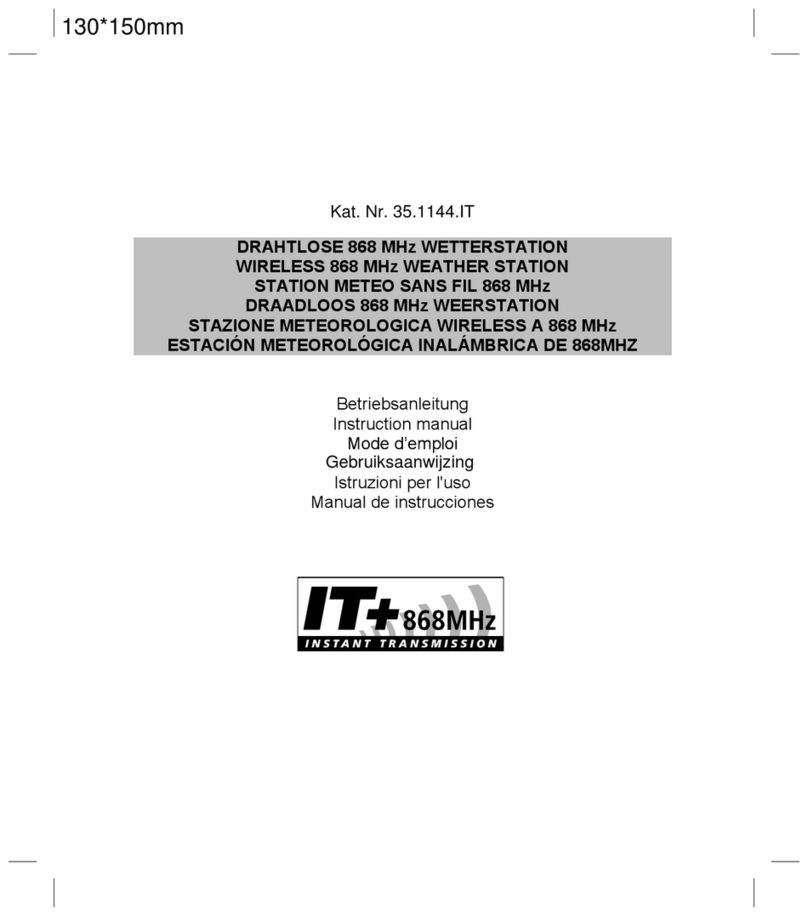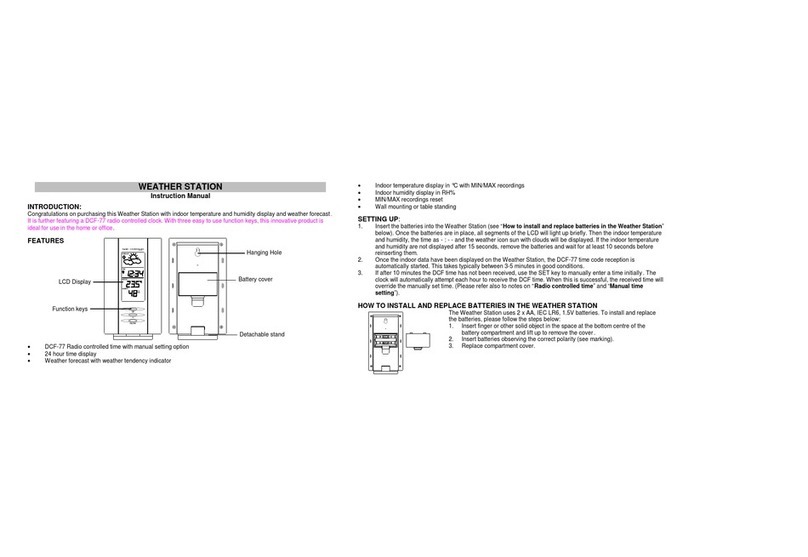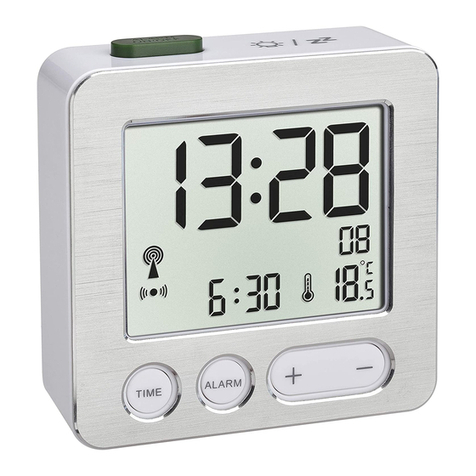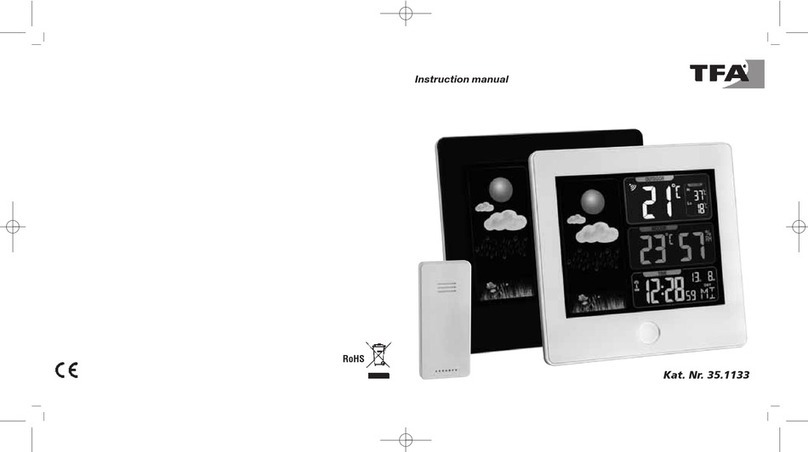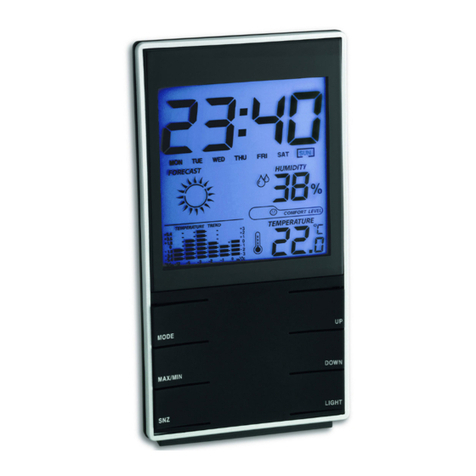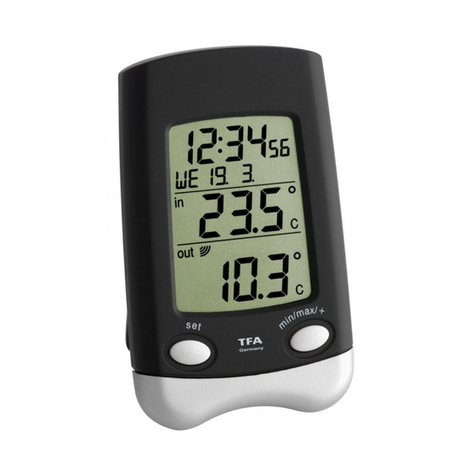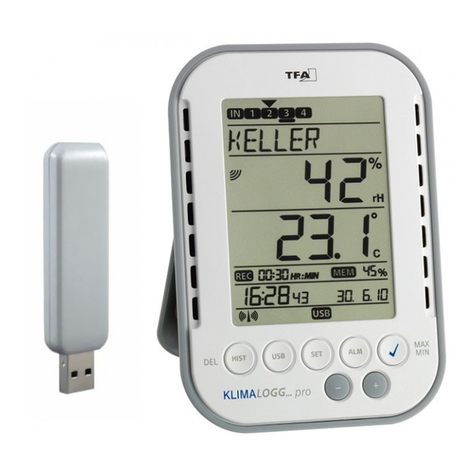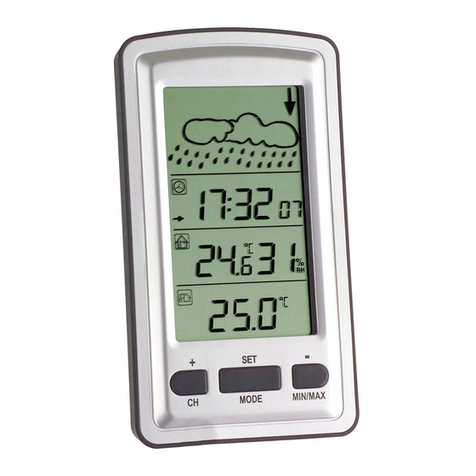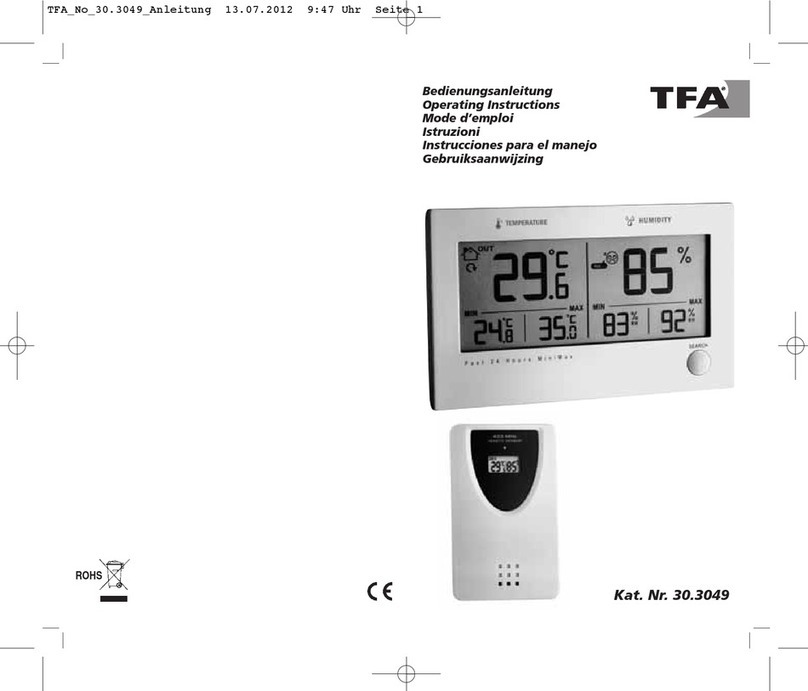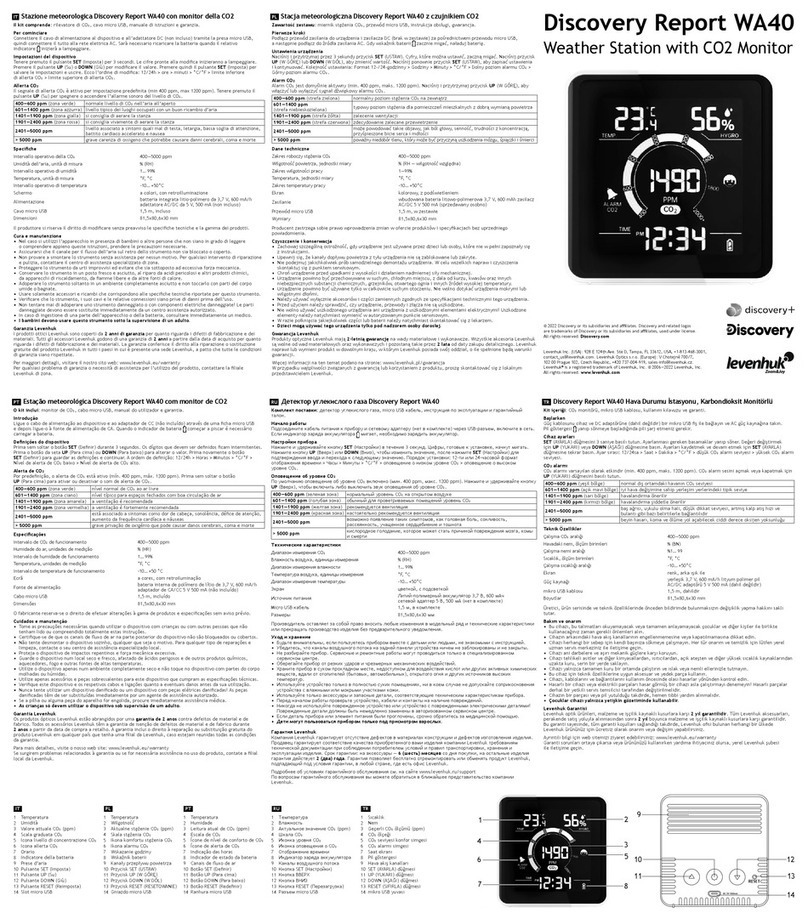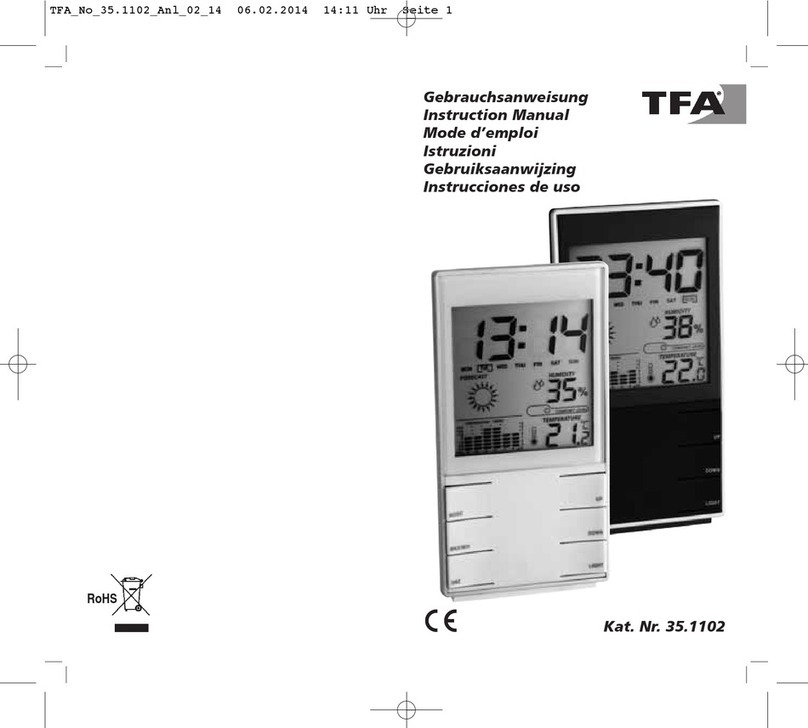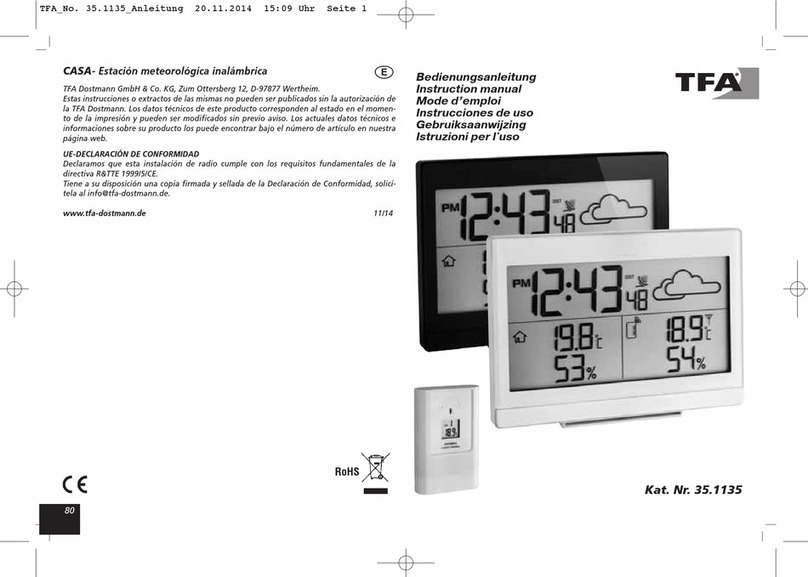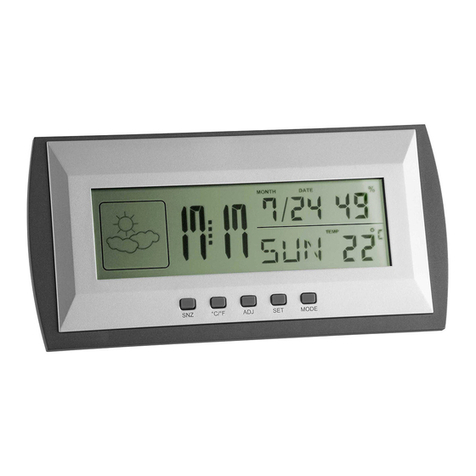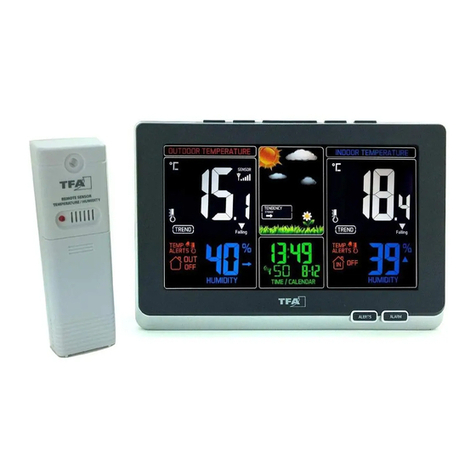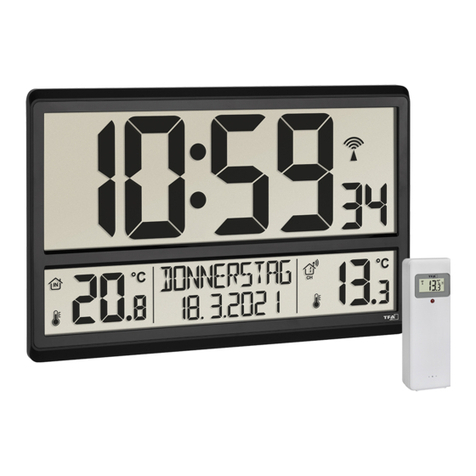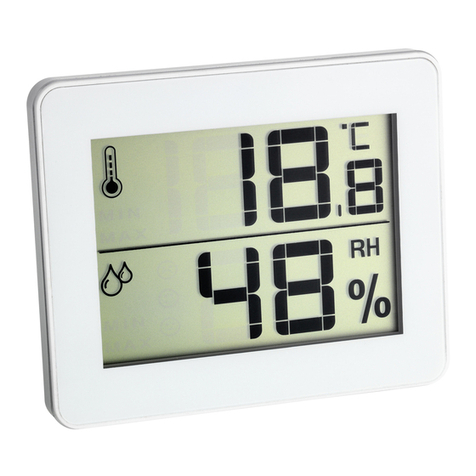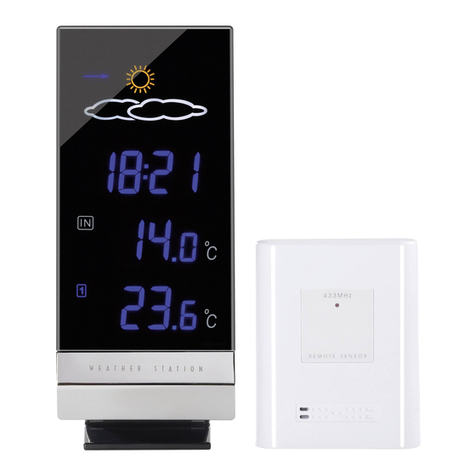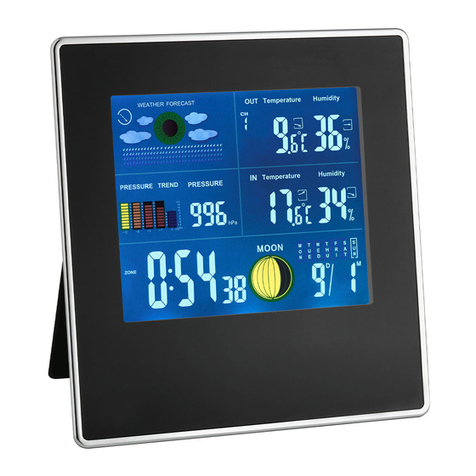98
MULTY - Funk-Wetterstation
MULTY - Funk-Wetterstation
8.1.2 Einstellung der Zeitzone
• Im Einstellungsmodus können Sie die Zeitzonenkorrektur (-12/+12) vornehmen.
• Die Zeitzonenkorrektur wird benötigt, wenn das DCF Funksignal empfangen wer-
den kann, die Zeitzone sich aber von der DCF Zeit unterscheidet (z.B. +1=eine
Stunde später).
• ZONE erscheint im Display.
• Drücken Sie die UP oder DOWN Taste.
• Bestätigen Sie die Eingabe mit der MODE Taste.
8.1.3 Einstellung der Spracheinstellung für den Wochentag
• Im Einstellungsmodus können Sie die Sprachauswahl für den Wochentag vorneh-
men: Deutsch (GE), Italienisch (IT), Französisch (FR), Niederländisch (NE), Spanisch
(ES), Dänisch (DA) und Englisch (EN).
8.2 Einstellung des Weckalarms
•
Drücken Sie die ALARM Taste.
• AL und 7:00 (Voreinstellung) oder die zuletzt eingestellte Weckzeit wird auf dem
Display angezeigt.
• Halten Sie die ALARM Taste gedrückt.
• Das Alarm-Symbol erscheint und die Stundenanzeige blinkt.
• Stellen Sie mit der UP oder DOWN Taste die Stunden ein.
• Drücken Sie die ALARM Taste noch einmal und Sie können nun die Minuten mit
der UP oder Down Taste einstellen.
• Bestätigen Sie die Eingabe mit der ALARM Taste. Der Alarm ist aktiviert.
• Drücken Sie die ALARM Taste noch einmal.
• Auf dem Display erscheint die aktuelle Uhrzeit.
• Wenn die eingestellte Weckzeit erreicht ist, beginnt der Wecker zu klingeln.
• Das Alarmsymbol blinkt.
• Drücken Sie auf eine beliebige Taste, um den Alarm zu beenden.
• Wird der Alarm nicht unterbrochen, schaltet sich der ansteigende Alarmton auto-
matisch nach ein paar Minuten aus und aktiviert sich erneut zur gleichen Weckzeit
wieder.
• Wenn der Alarmton ertönt, drücken Sie die SNOOZE-LIGHT Taste, um die Snooze-
Funktion zu aktivieren.
• Ist die Snooze-Funktion aktiviert, blinkt Zz auf dem Display.
• Der Alarm wird für die Dauer von 5 Minuten unterbrochen.
8.2.1 Aktivieren und Deaktivieren der Alarm-Funktion
• Drücken Sie die MODE Taste im Normalmodus, um die Snooze-Funktion auszu-
schalten.
• Drücken Sie die MODE Taste im Normalmodus noch einmal, um die Alarm-Funk-
tion auszuschalten.
• Das Alarm-Symbol und das Snooze-Symbol verschwinden.
• Drücken Sie die MODE Taste im Normalmodus, um die Alarm-Funktion wieder ein-
zuschalten.
• Das Alarm-Symbol erscheint.
8.3 Hintergrundbeleuchtung
• Drücken Sie die SNOOZE-LIGHT Taste, um die Hintergrundbeleuchtung für ein
paar Sekunden zu aktivieren.
• Falls die Funkuhr kein DCF-Funksignal empfangen kann (z.B. wegen Störungen,
Übertragungsdistanz, etc.), kann die Zeit manuell eingestellt werden. Das DCF-
Empfangszeichen verschwindet und die Uhr arbeitet dann wie eine normale
Quarz-Uhr (siehe „Manuelle Einstellungen”).
7. Hinweis zum Empfang der Funkzeit
Die Zeitübertragung erfolgt von einer Cäsium Atom-Funkuhr, die von der Physi-
kalisch Technischen Bundesanstalt in Braunschweig betrieben wird. Die Abweichung
beträgt weniger als 1 Sekunde in einer Million Jahren. Die Zeit ist kodiert und wird
von Mainflingen in der Nähe von Frankfurt am Main durch ein DCF-77 (77.5 kHz)
Frequenzsignal übertragen mit einer Reichweite von ca. 1.500 km. Ihre Funkuhr
empfängt das Signal, wandelt es um und zeigt immer die exakte Zeit an. Auch die
Umstellung von Sommer- und Winterzeit erfolgt automatisch. Während der Som-
merzeit erscheint „DST” im Display. Der Empfang hängt hauptsächlich von der geo-
graphischen Lage ab. Im Normalfall sollten innerhalb des Radius von 1.500 km aus-
gehend von Frankfurt bei der Übertragung keine Probleme auftauchen.
Bitte beachten Sie folgende Hinweise:
•
Es wird empfohlen, einen Abstand von mindestens 1,5 – 2 Metern zu eventuell
störenden Geräten wie Computerbildschirmen und Fernsehgeräten einzuhalten.
•
In Stahlbetonbauten (Kellern, Aufbauten) ist das empfangene Signal natürlicher-
weise schwächer. In Extremfällen wird empfohlen, das Gerät in Fensternähe zu
platzieren und/oder durch Drehen das Funksignal besser zu empfangen.
•
Nachts sind die atmosphärischen Störungen meist geringer und ein Empfang ist in
den meisten Fällen möglich. Ein einziger Empfang pro Tag genügt, um die Genau-
igkeit zu gewährleisten und Abweichungen unter 1 Sekunde zu halten.
8. Bedienung
•Wichtig: Während des Empfangs der Außenwerte und der Funkzeit ist keine
Tastenbedienung möglich.
•
Halten Sie die UP oder DOWN Taste im jeweiligen Einstellmodus gedrückt, gelan-
gen Sie in den Schnelllauf.
•
Das Gerät verlässt automatisch den Einstellmodus, wenn länger als 30 Sekunden
keine Taste gedrückt wird.
8.1 Manuelle Einstellungen
•
Halten Sie die MODE Taste im Normalmodus gedrückt. Die Jahresanzeige (2011 YR
- Voreinstellung) fängt an zu blinken und Sie können mit der UP oder Down Taste
das Jahr einstellen.
•
Drücken Sie die MODE Taste noch einmal und Sie können nun nacheinander den
Monat, den Tag, die Sprachauswahl für den Wochentag (GE - Voreinstellung), die
Zeitzone (00 - Voreinstellung), die 12- und 24 Stunden-Anzeige (24H - Voreinstel-
lung), die Stunden und die Minuten und ansteuern und mit der UP oder Down
Taste einstellen.
•
Bestätigen Sie mit der MODE Taste.
•
Bei erfolgreichem Empfang des DCF-Funksignals wird die manuell eingestellte Zeit
überschrieben
8.1.1 Einstellung der 12- und 24 Stunden-Anzeige
•
Im 12-h-System erscheint AM oder PM (nach 12 Uhr) auf dem Display.
•
Mit der UP oder DOWN Taste können Sie im Einstellungsmodus das 12- oder 24-
Stunden-Zeitsystem auswählen.
TFA_No. 35.1134_Anleitung 17.02.2015 10:41 Uhr Seite 5
